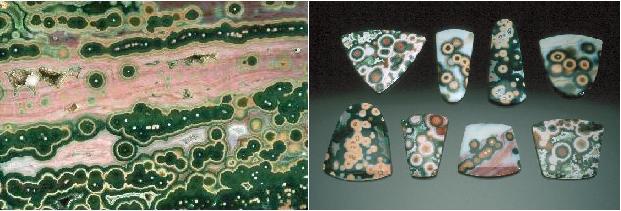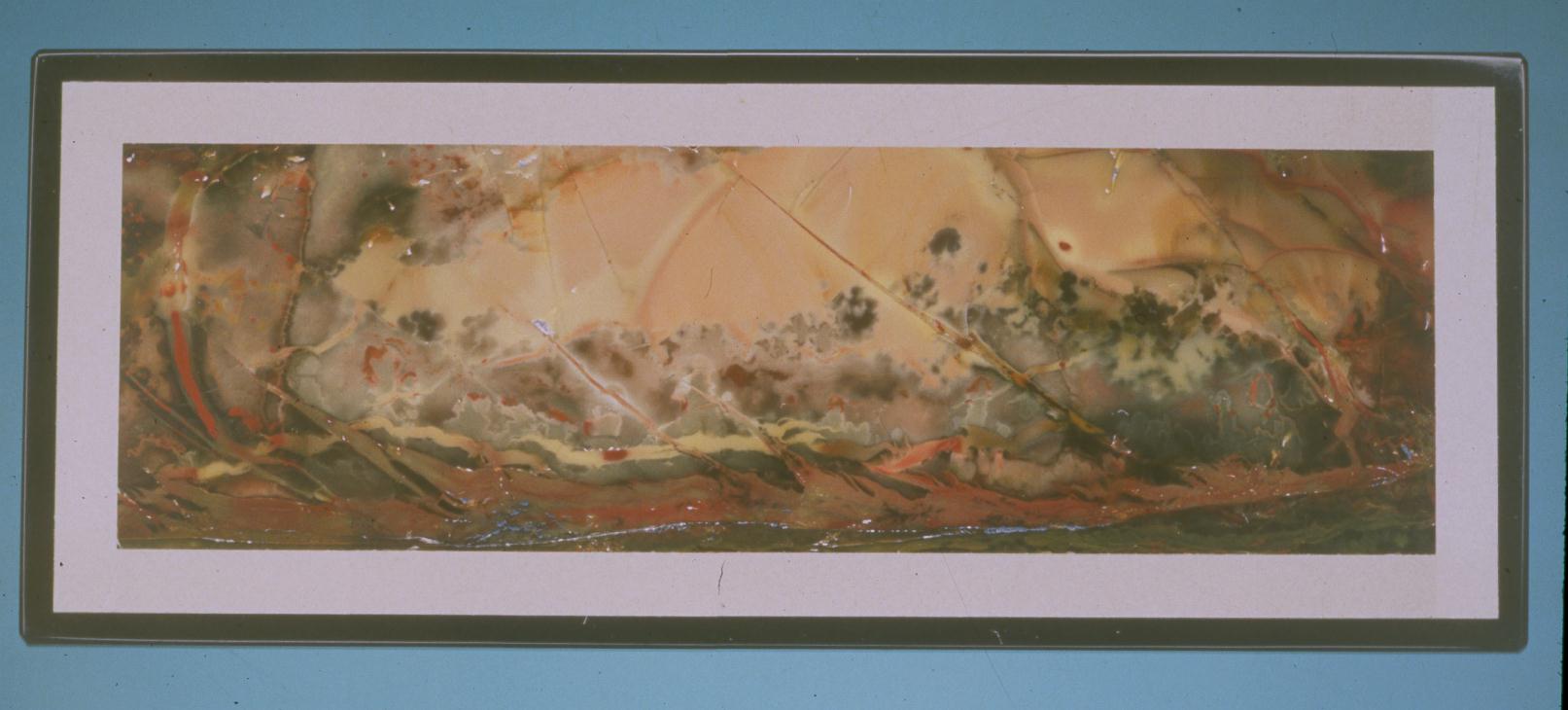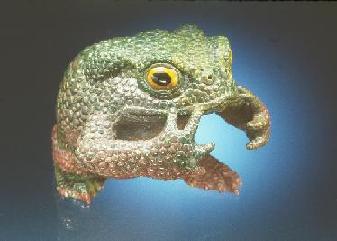JASPER
( Fr- jaspe; Ger- Jaspis;
Nor- jaspis; Rus-  )
)
JASPER (See also CHALCEDONY and CHERT entries.)


A. Jasper toad, top,
(height - 7.5
cm) by Gerd Dreher. Betty Llewellyn Collection. (© photo by
Jeffrey A. Scovil)
B & C. Orbicular Jasper, center.
Left: slab (field of view, width - 13.8 cm). Gilbert Gauthier
collection. Right: cabochons (heights - up to 5.3
cm). Don Olson & Associates. This jasper, from
Madagascar, is widely marketed as "Ocean jasper." The diversity of
patterns exhibited by these cabochons provides examples of the
virtually innumerable possibilities lapidaries have when fashioning
pieces from this rock. (© photos by Jeffrey A. Scovil)
D. Jasper, bottom.
Morrisonite (width
-
7.6 cm). Don Olson & Associates. (© photo by Jeffrey A.
Scovil)
DESCRIPTION: Dense microcrystalline quartz
-- some people describe jasper as similar to chert whereas others
compare it to chalcedony; my observations favor the correlation with
chert because virtually all of the rock I have seen that has been
called or labeled jasper is opaque or subtranslucent in thin splinters
and has a dull to
pearly luster like chert, which is quite different from the typical
translucency and subvitreous luster of most chalcedony. Nonetheless
distinguishing certain specimens as one versus the others of these
rocks is subjective and based on the experiences of the person naming
them.
Colors - typically red of diverse hues or
brown; less commonly green or just about any color, white, gray or
black; even less commonly zoned -- e.g., ill-defined stripes that are
yellow, bluish,
purplish, gray or nearly black -- with some specimens cloudy,
variegated,
roughly banded and/or spotted. In practice, color leads to some
of the problems that arise when one is naming some materials
jasper rather than chert: a "rule of thumb" (albeit based
on
one's subjective sense of and feelings about color) to which I
subscribe, is "if the given rock exhibits attractive colors
call it jasper, otherwise
call it chert."
H. ~
7
S.G. 2.5-2.9
Light
transmission - typically opaque (cf. agate)
Luster - dull to pearly
Breakage -
subconchoidal fracture.
OTHER NAMES: Nomenclature for
diverse jaspers
is not well established. -- The chief differences relate to the fact
that
some definitions are primarily descriptive whereas others are
genetically or economically
based. In any case, anyone interested in collecting jasper should
ever remain aware of the fact that jasper is treated in vast literature
of economic geology.
As one might suspect for a gemrock of such
widespread occurrence, jasper has been given many names. Adjectives and
monomial terms applied have been based on such things as color and
arrangement of colors, localities of occurrence, names of persons who
were connected with the material, names thought
to appeal to potential purchasers of items made from jasper, etc.,
etc.
Several of these names have been recorded by Hart (1927); Dake,
Fleener, and Wilson (1938); GIA (1974); and Mitchell
(1985). Some examples follow:
- Australian jasper - jasper speckled with
flecks of red and light grey.
- Band (or banded) jasper - an alternative name
for riband jasper.
- Bayate - local name for brown
jasper from Cuba.
- Blood jasper - misnomer for bloodstone.
- Bruneau jasper - beautifully patterned brown
or reddish brown and cream colored jasper from Bruneau River Canyon,
Owyhee County, Idaho
- "Bumble Bee
Jasper" a misnormer -- i.e., NOT jasper; see Appendix A.
- Candy rock - see statements under REMARKS
subheading in RHYOLITE entry.
- Catalinaite (also spelled Catalinite)
- Jasper/sardonix pebbles found on shores of Santa Catalina
Island in the Gulf of California, Mexico.
- Cave Creek jasper - rather bright red jasper
from Maricopa County, Arizona.
- Chrysojasper - jasper colored
with chrysocolla.
- Cinnabar matrix - "term applicable to various
varieties of minerals containing numerous inclusions of cinnabar but
especially to a Mexican variety of jasper." (Shipley, 1951)
- Creolite - red and white banded jasper from
San Bernardino and Shasta counties, California.
- Dallasite - green and off-white jasper from
Vancouver Island, British Columbia, Canada.
- Dalmatian jasper - off-white jasper with
scattered black spots from an unspecified locality.
- Egyptian jasper - brown
and banded jasper that occurs as sporadic pebbles, cobbles and small
boulders on the desert between the
Red Sea and Cairo, Egypt.
- Elephant jasper - brown jasper containing
small black dendrites or exhibiting a spider-weblike pattern.
- Frogskin jasper - grayish tan
jasper with sporadic irregular green patterns from Chihuahua, Mexico.
- Heliotrope - this name, widely
applied to the bloodstone variety of chalcedony, has been recorded as
"green jasper with [a] few small red dots" for an
intaglio that is in archives of the Institute of Archaeology at Hebrew
University, Jerusalem, Israel (Peleg,
2003)
- Imperial jasper - name given to a Mexican
jasper that is variegated in green and yellow hues and is in part
translucent so it exhibits diverse interesting patterns in transmitted
as well as reflected light.
- Iolanthite - local trade name
for a banded reddish jasper found as pebbles in Crooked River, central
Oregon.
- Jasp agate (agate jasper, jasp
fleuri, and jasponyx) - names sometimes given material that
1.consists of bands of transparent chalcedony and subtranslucent
jasper, or 2.is deemed intermediate between jasper and
agate.
- Jasper breccia -
term applied to two different
materials: 1.breccias the larger fragments of which are jasper and
2.breccias that have been jasperized.
- Jasperine - name sometimes applied to color
banded jasper.
- Kinradite - trade name for orbicular jasper
that contains white or nearly colorless spherulites of quartz, from
Point Bonita near the Golden Gate Bridge, California. See also
Oregonite.
- Lantana - name given chalcedony, banded agate
or jasper beads produced in Ilorin, Nigeria during the 19th and 20th
centuries (Lui, 1995).
- Leopardskin jasper (also leopard jasper)
- buff to orangish tan jasper with sporadic dark brown to nearly black
spots or rings (typically about
1/4 inch in diameter), the overall pattern of which resembles
that of leopards' coats.
- Moss jasper - jasper with features similar to
those of moss agate from the Mojave Desert of California.
- Morrisonite - marketplace name for a
varicolored jasper, which apparently had a volcanic ash precursor, from
near the southern end of Lake Owyhee, Malheur County, Oregon (see Fig.
D).
- Moukaite - name sometimes given to light pink
jasper from Australia.
- Morlop - name sometimes applied to mottled
jasper.
- Mtorolite - "a uniform dark green jasper sent
to me by someone from Africa, calling it that ...
it may be a locality designation, perhaps associated with a settlement
in the Mtwara administrative district of southeastern Tanzania."
(Frederick Pough, personal communication, 1998); see also chrome
chalcedony
and mtorolite in the CHALCEDONY entry.
- Mushroom jasper - cabochons,
beads, pendants have been marketed widely as as mushroom agate,
mushroom jasper and mushroom rhyolite, which is said to have been
metamorphosed. All, if indeed there are three differently
constituted ones, are said to come from Arizona. I have
seen only photographs of any of these, but all appear to be virtually
the same material. The photographs do indicate that the pattern
exhibited by the polished surfaces resemble mushrooms.
- Nunkirchner jasper - a rather
dull grayish brown jasper from the vicinity of Idar-Oberstein, Germany.
- Ocean jasper - marketplace name for the jasper, from
Madagascar, that is shown as Figures B & C
and
described by Johnson et al. (2000). Additional information and some fine
photographs are given by Tremblay and Cesare (2014).
- Oolitic red jasper - this hematite-pigmented
jasper, which I have found constituting beach pebbles along the shores
of Lake Michigan and Lake
Superior could be fashioned into striking beads, earrings,
small pendants, etc. This
rock certainly has a good potential
so far as use as a gemrock IF the
source rock is found to be available in quantities sufficient for
economical recovery.
- Orbicular jasper - jasper with sporadic
orbicules -- i.e., roughly spherical zones -- with one or more
colors different from the color of the main mass. One noteworthy
source is Morgan Hill, Santa Clara County, California. See also kinradite, oregonite, owyhee jasper, ocean
jasper and poppy-patterned
jasper (etc.).
- Oregonite - trade name sometimes given to
kinradite (q.v.) from the area near Grants Pass, Oregon.
- Owyhee jasper - name sometimes given to
orbicular jasper in the marketplace.
- Paradise jasper - local trade
name for variegated red jasper from Morgan Hill, California.
- Pastelite - jasper characterized by pastel
colors --e.g., pinks, light greens and tans -- that appear as
wavy lines in articles fashioned from it. This jasper is rather
widespread in western United States.
- Petrified wood - much petrified wood is
largely, if not wholly, jasper; see Xyloid jasper and FOSSILIFEROUS
ROCKS entry.
- Picture jasper - name applied
to scenic jasper (q.v.)
included in the Janet
Annenberg Hooker Hall of Geology, Gems and Minerals of the National
Museum of Natural History (Smithosonian Institue), Washington, D.C.
- Poppy-patterned jasper (poppy
jasper and poppy stone)
- trade name(s) for orbicular jasper
that contains sporadic relatively bright red, orange or yellow
orbicules, typically within a yellowish green background,
from the Paradise Valley and Llagas Creek, California.
- Riband jasper (also ribbon
jasper) - jasper with bands of different colors.
- Rogueite - greenish jasper found in gravels of
Rogue River, Oregon.
- Russian jasper - name sometimes given
red-flecked jasper.
- Scenic jasper (picture jasper) -
typically light tan jasper with dark brown lines that, when
cut in certain directions, exhibit patterns
that resemble natural panoramas of, for example, rolling topography
and/or shorelines. A particularly noteworthy example is the
jasperized volcanic ash, sometimes referred to as Biggs
jasper, from Biggs Junction, Sherman County, Oregon.
- Sioux Falls jasper - a multicolored jasper
from Sioux Falls, South Dakota that has been used for such things as
tabletopss and interior architectural
trim.
- Swiss lapis - a blue (apparently dyed) jasper,
sometimes marketed as a lapis lazuli substitute.
- Vabanite - a reddish brown jasper with yellow
flecks and/or streaks from California.
- Variegated jasper - name sometimes given
rather high-quality jasper from the San Francisco region, California.
- Wilkite (Willow Creek jasper) -
"delicately colored yellow, purple, pink, and green variety of jasper,
found near Willow Creek, north of Eagle, Ada
County, Idaho." Mitchell (1985).
- Wonderstone - see statements re Eagle Peak,
New Mexico rock under REMARKS subheading in RHYOLITE entry.
- Xyloid jasper - petrified wood that consists
largely of jasper - i.e., jasperized wood .
- Zebra jasper - a dark brown jasper with
lighter brown to nearly off-white steaks from India and South Africa.
- Zonite - term applied to various
colored jasper and chert in
Arizona.
USES: Jasper has found widespread use in
jewelry and for fashioning ornaments since its early use as beads and
for seals. Black jasper was used for intagli in
Roman times (King, 1965, p.123); most "Indian beggar beads"
consist at least in part of diversely colored jasper; many
carvings are
made of jasper; diverse jaspers
have been used to make buttons...
OCCURRENCES: Much jasper appears to
represent replaced limestone or dolostone -- in some places, extensive
beds of those rocks. It also occurs as a veins and nodules and
otherwise configured components, commonly as part of the gangue of
mineral deposits that appear to have formed as the result of
hydrothermal or metasomatic processes.
NOTEWORTHY LOCALITIES: See the
localities noted with the terms listed under the OTHER NAMES
subheading. As might be suspected from going through that list,
jasper is relatively common -- Merrill's
catalog entries (1922, p.25-26) for nine specimens in the U.S.
National Museum collections include the following localities: Egypt
(Nile River), England (Hertfordshire), India, Saxony, Siberia, and
"Locality not recorded." And, that list is fairly exemplary of
the rather
non-definitive locality labels I have seen on numerous specimens of
jasper in several museums and private collections. In addition, it is
common to see one locality listed for several diverse samples -- e.g.,
I suspect that labels reading simply San Bernardino California,
indicate only that the specimens came from somewhere within the general
area along Route 40 between Ladle and Newberry Springs, California.
Special attention is directed to Frondel's (1962)
treatment of jasper -- in the Silica Minerals volume of the seventh
edition of Dana's "System ..." -- where several localities for
diversely colored jasper are recorded. Also, Evseev (1994, p.48) gives
the
following entry -- repeated here because of the relative difficulty in
obtaining a copy of the publication in which it occurs:
"Jasper -- Since the 18th
century, the Altai has been famous for decorative jasper varieties,
which are used in large items -- Revnevskoye deposit (near the town of
Zmeinogorsk) -- grey-green banded jasper (a large chunk of the Revnev
jasper was used to manufacture a unique 3 x 5 m vase and columns in the
Hermatage ... headwater of the Charysh River -- white jasper
with black dendrites; Korgon River (confluent of the Charysh River) --
beautiful grey-violet porphyry; Transbaikalia -- 'Egyptian jasper'
Ir-Nimi deposit (Far East) -- 'watercolor' jasper whose peculiar
coloring is formed by bright blue patches on the red, dark grey, and
brown background; specimens from this deposit came to be known quite
recently in the 1970-1980s."
REMARKS: Jasper is recorded in ancient
manuscripts (e.g., Exodus
XXVII:20). Its etymology, as given in several references, is
approximately the following: Middle English (jaspre); from Latin (iaspis); Greek (ιασπιϛ - iaspis); Persian (yašhm); Arabic (yašb); Hebrew (yāšhpêh);
Assyrian/Akkadian (ašhpū).
The color and opacity of jasper
is dependent
upon its being so-to-speak "chuck full" of microscopic and
submicroscopic
inclusions,
commonly of hematite and other iron-bearing minerals.
A velvety black variety of jasper, called Lydian
stone or basanite, was formerly used as a touchstone -- i.e.,
a stone whose smooth surface when scratched with, for
example, gold or silver or certain alloys, exhibits streaks that can
be compared to streaks of known metals or alloys, and thus provide a
means of identification, including even measurements of such things
as the material's gold content.
Red jasper and yellow jasper are thought by some
scholars to have occupied positions one and ten, respectively, in
Aaron's breastplate (see GLOSSARY); other scholars have suggested
that jasper occupied either the fifth or sixth
position. In addition, the term given the
twelfth stone of the Breast plate of the High Priest, Yashpheh,
has sometimes been translated as green jasper.
Jasper is indicated to constitute the first
foundation of walls of the
Heavenly City (Revelation, XXI:19).
SIMULANTS:
Bloodstone - this chalcedony gemrock [see CHALCEDONY entry] is
sometimes
called blood jasper. In my
opinion, this reported nomenclature seems outlandish -- considering
their market values, it seems much more likely that jasper resembling
bloodstone would be marketed as a bloodstone simulant. However, I must
admit that some bloodstone looks more like jasper than like chalcedony.
- [In any
case, fracture surfaces of chalcedony tend to be shinier than fracture
surfaces of jasper.].
***Glass - Marilyn Jobe of Ellenton, Florida has
fashioned beads from glass that closely resembles brecciated jasper -
[inferior hardness].
***Iris jasper - an Iimori glass - [vitreous
luster; inferior hardness].
***Jasperware (jasper ware) - Wedgwood china
that
resembles jasper, which has been molded into, for example,
cameo-appearing pieces used in pendants, brooches, and earrings. -
[Appearance suffices.].
***Porcelain jasper - "Hard, naturally baked,
impure clay or porcellanite, which, because of its red color, resembles
jasper" (Mitchell, 1985) - [Although appearance may suffice,
non-macroscopic
means are often required.].
Sioux Falls jasper - brown quartzite used as a
gemrock; from vicinity of Sioux Falls, South Dakota. - [vitreous
luster].
In an opposite sense, the name Oriental jasper
has been applied to bloodstone. - [As noted under the DESCRIPTION
subheading, distinguishing some chalcedony from jasper, and even from
some chert, is commonly subjective.].
REFERENCES: Blair, 1982;
Dake, Fleener
and Wilson, 1938; Frondel, 1962; Lovering, 1972.
| Top | Home |
R. V. Dietrich © 2015
Last
update: 11 December 2014
web page created by Emmett Mason
![]() )
) 

